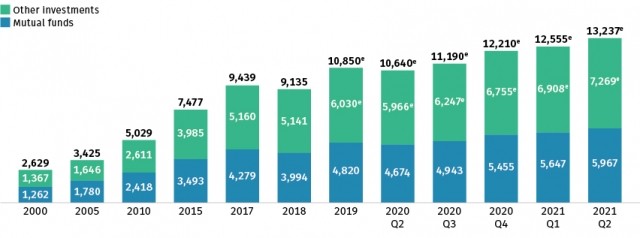Frequently Asked Questions About Individual Retirement Accounts (IRAs)
What are IRAs?
In 1974, the Employee Retirement Income Security Act (ERISA) created individual retirement accounts (IRAs). Congress initially designed IRAs to have two roles: (1) to give individuals not covered by retirement plans at work a tax-advantaged savings plan, and (2) to play a complementary role to the employer-sponsored retirement system by preserving rollover assets at job change or retirement. Over the past several decades, this flexibility has helped millions of US households save for retirement through IRAs.
IRA Market Assets
Billions of dollars, end-of-period, selected periods

e Data are estimated.
Note: Components may not add to the total because of rounding.
Sources: Investment Company Institute, Federal Reserve Board, American Council of Life Insurers, and Internal Revenue Service Statistics of Income Division
How large is the IRA market?
IRAs have been one of the fastest growing components of the US retirement market during the past decade. Totaling $13.2 trillion in assets at the end of the first half of 2021, IRA assets represented more than one-third of the $37.2 trillion US retirement market. Assets held in IRAs have increased on average 10 percent per year over the past 25 years, from $1.4 trillion in 1996.
How many US households own IRAs?
Millions of Americans use IRAs to save for retirement. An estimated 47.9 million US households, or 37 percent, owned IRAs as of mid-2019. An estimated 36.8 million households owned traditional IRAs, making it the most common type of IRA. A total of 26.3 million households owned Roth IRAs, and 8.6 million US households owned employer-sponsored IRAs such as SEP IRAs, SAR-SEP IRAs, or SIMPLE IRAs.
Where do IRA owners invest their money?
As of June 30, 2021, an estimated 45 percent of IRA assets were held in mutual funds, while the remaining assets were held in brokerage accounts or managed by banks or insurance companies. In 2000, mutual funds’ share of IRA assets stood at 48 percent.
What role do IRA investments play in the mutual fund industry?
IRA assets held in mutual funds represented about 23 percent of total mutual fund assets as of June 30, 2021, or $6.0 trillion.
How are IRA mutual fund assets allocated?
At the end of June 2021, 44 percent of mutual fund assets in IRAs were invested in domestic equity funds. World equity funds held 14 percent, hybrid funds (which include the bulk of target date and lifestyle funds) held 19 percent, bond funds held 17 percent, and money market funds held 6 percent of IRA mutual fund assets.
What are annual IRA contribution limits?
Tax legislation, enacted in 2001 and 2006, contained several significant provisions designed to encourage greater retirement savings, including gradual increases in annual IRA contribution limits. In 2002 through 2004, the annual contribution limit for both traditional and Roth IRAs was $3,000. The contribution limit increased to $4,000 for tax years 2005 through 2007, to $5,000 for tax years 2008 through 2012, and to $5,500 for tax year 2013. The annual contribution limit increased to $6,000 in 2019. Furthermore, individuals aged 50 or older may be eligible to make additional “catch-up” contributions.
Where can I find more information on IRAs and IRA investors?
ICI also conducts research on US household ownership of IRAs and tracks assets and other statistical data on the IRA and defined contribution plan retirement markets. In addition, research has also analyzed the history of IRAs and the evolving role of IRAs in US retirement planning.
October 2021

